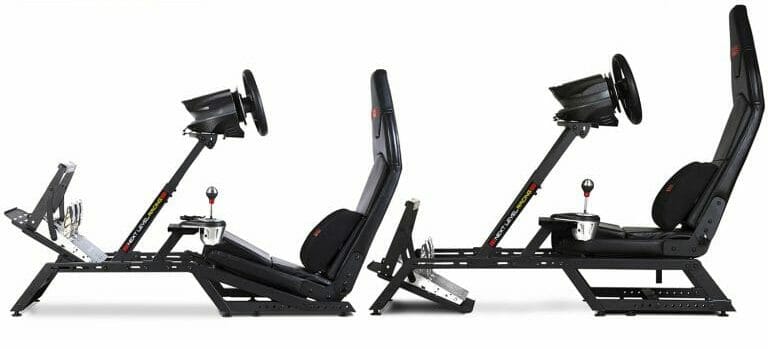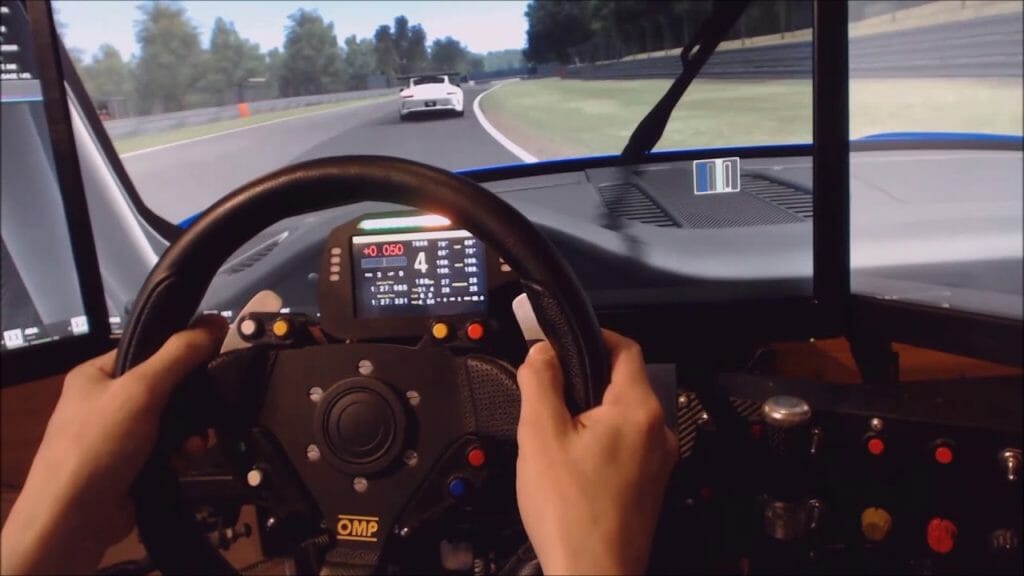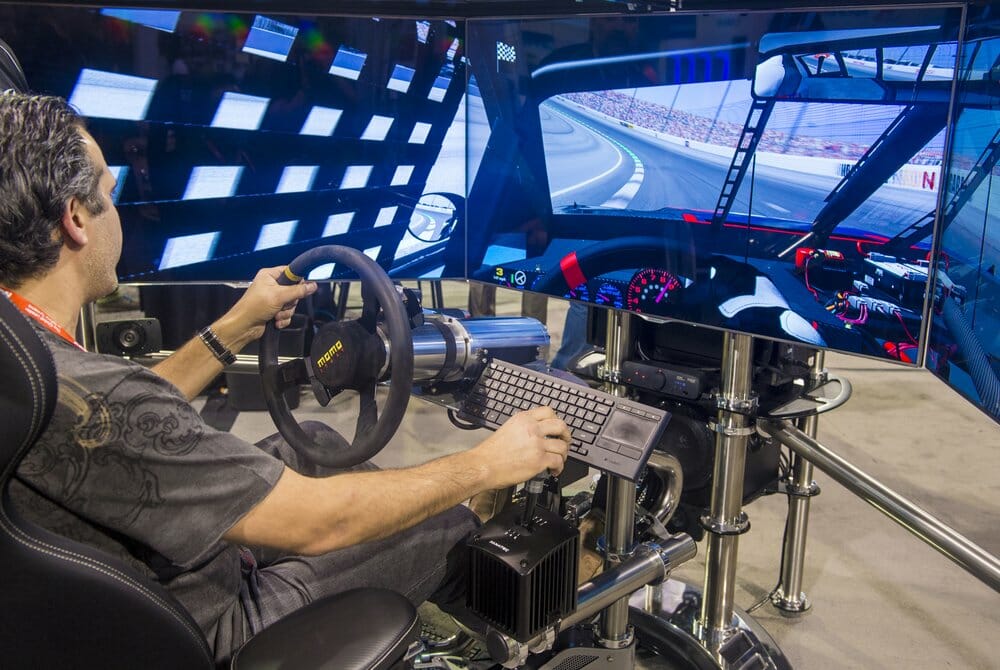Though certainly not as physically demanding as real life racing, sims still require you to have control over your body. High quality products will take into account even the smallest change in pressure and angle, so your posture becomes key, as any small twitch may lead you to make mistakes. In this guide we will cover all the basics in order for you to have the best seating position for your driving performance.
The Seat
The first step in finding your driving position is adjusting your racing seat (or cockpit!). Before we progress any further, make sure that your seat does not have wheels. With those kinds of seats you’ll constantly be moving around, making the process of finding the correct position not only useless, but also distracting you from the driving. Obviously the best possible choice is a dedicated race seat, but if you don’t have those available a simple fixed seat will do.
Secondly, all the measurements we want to take are from the virtual floor. That means that you need to look at the heel plate of your pedals, and not the floor itself. So if your heel plate is 2 inches above the ground, all measurements should start at 2 inches above the ground. Needless to say that if you don’t have a heel plate then your physical floor and virtual floor are the same.
The position you will want to take is a GT-style seating position, rather than an F1 seating position. This will be more comfortable for you and will allow for longer sessions. When you take this position the underside of your knee should be between 8 and 11 inches above the virtual floor. Remember, this is not the same position you would have while sitting down for dinner, but is rather a slightly backwards inclined position. The reason for this is twofold: ergonomically you will be more comfortable than in an F1 position (your back will not curve as much, and you don’t need to worry about keeping a very low centre of gravity like a real F1 driver needs to). Secondly, you will have a better driving position than if sitting upright. Your use of pedals will be more precise, and the steering wheel will be at the correct height and distance from the monitor.

The Wheel
Calculating from the virtual floor, the centre of the wheel should be between 23 and 27 inches from the ground. Roughly speaking this means that the top of your steering wheel should be shoulder-height (and definitively not higher). For this, you might well want to invest in a good wheel stand or cockpit.
Once you have the wheel height figured out, you need to look at distance. Returning to your GT position, extend your arms. From this position the distance your wheel should be from you is around halfway between your wrists and elbow.
 Fanatec Podium DD1
Fanatec Podium DD1
To see whether the wheel height and distance are correct, place your hands at 3 and 9 o’clock respectively. You should then be able to turn 180° to the left, and 180° to the right without feeling the need to take your hand off the wheel. If you can do that then the wheel is correctly set. As a quick aside, it’s important for you to test this out as, when you turn, the hand on the top of the wheel will be the one that has the most control and feeling on the track.
The Pedals
You should already have a rough idea as to where the pedals should be from your knee height. The most important thing to note here is to find what is most comfortable for you. Some racers prefer to have their legs slightly more extended, some prefer to have them slightly more compressed.
 Fanatec ClubSport V3
Fanatec ClubSport V3
Either way here are some common mistakes people make when first setting up their racing station. You should make sure that your legs and knees do not come into contact with the wheel. It’s pretty self-explanatory why, but it’s a common mistake that could cause you to lose a lot of precision and competitiveness. Similarly, you do not want your legs to be fully extended, as you’ll have trouble actually pressing down on the pedals. Your driving position should be that it’s comfortable for you to both press down on, as well as rest your feet on, the pedals.
On the topic of pedals, a few important ergonomic notes: your feet need to always be on the pedals. If they aren’t your body will both be less precise and you will require more time to make quick changes or brakes. Another very important note is how to press down on the pedals. As ridiculous as this may sound you want to change the pedal angle by using the balls of your feel, not the entire sole. This will make you use your longer and stronger leg muscles rather than your foot muscles, preventing fatigue and (potentially) injuries. Finally, your pedals should not move while you’re racing, or all of this will have been for nothing.
The Monitor
For those with a single monitor, your monitor should be behind the wheel, but close to it. The most important factor however, is the monitor height. If you have a friend that can help set up your station, the next step will be considerably easier. Grab and fold a piece of A4 paper in half (lengthwise). The apex of the paper should then be placed in the exact middle of the monitor. When you’re sitting down you should be able to look down the fold without any issue. If that is the case then the monitor is set up correctly. As a last note, don’t worry if your wheel is blocking the bottom part of the screen. This is what a real life driver would see too. If you are able to see what’s in front of your car then you’re set!

Obviously with more monitors the set-up becomes more complicated, but only slightly. Follow the steps in the above guide to set-up the central monitor. Once that is done replicate the same thing with the other two monitors (but use two more pieces of paper, you’ll need all three to test whether they’re set up well or will need further adjustments). The angle of your side monitors will depend on how close your screen is to the wheel, and how large the wheel is. What is crucial is that all monitors are the same height. Place the other two pieces of paper on the side monitors in the same way as you had done for the central monitor (with the apex hitting the middle of the screen). The monitors will be the correct vertical height when you can see down the folds of all the papers by only turning your head (and not moving or adjusting your body). Once that is done we can move on to the adjustment of other peripherals!
Shifters, Handbrakes, and Other Accessories
Shifters, handbrakes, and other accessories are the items that allow you the most flexibility in positioning. Generally speaking all your choices should reflect what allows you to make adjustments as quickly as possible. Ergonomically this means that your handbrakes/shifters need to be as close to the steering wheel as possible without them interfering with your hands. The height we recommend is no higher than the centre of the wheel, but no lower than the bottom of it. That way your hand should only be a small shoulder rotation away from changing gears. If you notice you’re bending your elbow to make changes then your setup might be suboptimal.
Before you race, set everything up and test whether it’s still comfortable for you to rotate the wheel 180° to both sides while the accessories are next to you. If you’ve checked all the boxes then you should be ready to hit the track!
Last Note
We’ve done our best to provide a quick but comprehensive guide on how to create an ergonomic driver’s seating position that gives you all the advantages possible for when you race. That being said it’s impossible for this guide to work perfectly for every single user. At the end of the day your comfort is what will best dictate whether you’ll perform well or not. So, as a last step, race using this set-up for a while. If something still doesn’t feel right make a handful of small changes at a time until you find what works for you. Most importantly, have fun!
Last Updated on July 9, 2021


